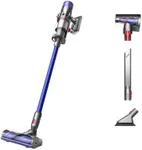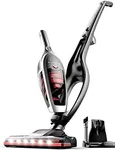Buying Guide for the Best Allergy Vacuums
When choosing a vacuum cleaner specifically designed for allergies, it's important to focus on features that will help reduce allergens in your home. These vacuums are designed to capture and contain dust, pollen, pet dander, and other allergens, ensuring that they don't get released back into the air. By understanding the key specifications and how they relate to your needs, you can make an informed decision and select the best vacuum for your situation.Filtration SystemThe filtration system is crucial in an allergy vacuum because it determines how well the vacuum can trap allergens. High-Efficiency Particulate Air (HEPA) filters are the gold standard, as they can capture 99.97% of particles as small as 0.3 microns. This is important for allergy sufferers because it ensures that even the tiniest allergens are trapped. When choosing a vacuum, look for one with a true HEPA filter. If you have severe allergies, consider a vacuum with a sealed system to prevent any particles from escaping.
Suction PowerSuction power refers to the vacuum's ability to pick up dirt and debris from various surfaces. For allergy vacuums, strong suction is important to ensure that all allergens are effectively removed from carpets, rugs, and hard floors. Suction power is often measured in air watts (AW) or amps. Higher values generally indicate better performance. If you have thick carpets or pets, opt for a vacuum with higher suction power to ensure thorough cleaning.
Dustbin or Bag CapacityThe dustbin or bag capacity determines how much dirt and debris the vacuum can hold before it needs to be emptied. For allergy sufferers, it's important to minimize exposure to allergens when emptying the vacuum. Bagged vacuums are often preferred because they contain the dust more effectively and are easier to dispose of without releasing allergens back into the air. If you choose a bagless vacuum, look for one with a hygienic emptying system to reduce contact with dust.
Attachments and AccessoriesAttachments and accessories can enhance the vacuum's ability to clean different surfaces and hard-to-reach areas. For allergy vacuums, look for attachments like a motorized brush for carpets, a crevice tool for tight spaces, and an upholstery tool for furniture. These tools can help you remove allergens from various surfaces more effectively. Consider your specific needs, such as whether you have pets or need to clean stairs, and choose a vacuum with the appropriate attachments.
Noise LevelThe noise level of a vacuum can be an important consideration, especially if you are sensitive to loud sounds or have young children or pets. Noise level is measured in decibels (dB). Quieter vacuums typically have a noise level of around 60-70 dB, while louder models can exceed 80 dB. If noise is a concern for you, look for a vacuum with a lower decibel rating. Keep in mind that some powerful vacuums may be louder, so you may need to balance noise level with suction power.
Weight and ManeuverabilityWeight and maneuverability are important factors to consider, especially if you have a large home or multiple floors. A lightweight vacuum is easier to carry and maneuver around furniture and up and down stairs. Some vacuums come with swivel steering or other features that make them easier to navigate. If you have mobility issues or need to clean a large area, look for a vacuum that is lightweight and easy to handle.























